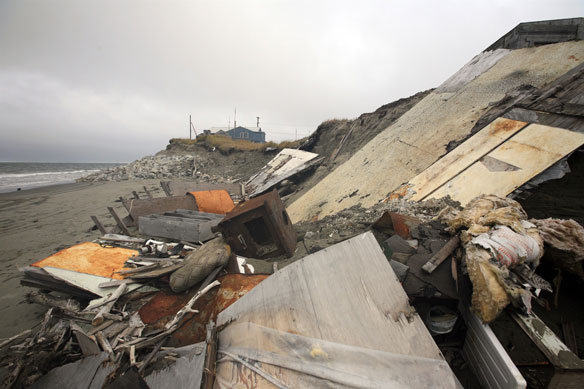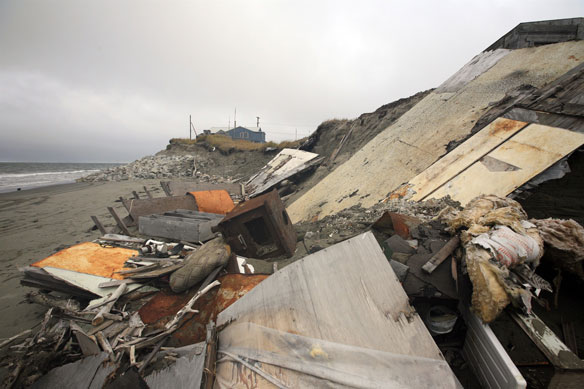
Alaska, houses collapsing due to coastal erosion. The village and homes are being destroyed by a rising tide, to the point where homes are being abandoned as they literally fall into the ocean. Residents can do nothing to stop the water as it approaches their homes. Captions and Photo source: ©© Laurence Hislop / UNEP
By USGS;
In a new study published July 1st, scientists from the U.S. Geological Survey found that the remote northern Alaska coast has some of the highest shoreline erosion rates in the world. Analyzing over half a century of shoreline change data, scientists found the pattern is extremely variable with most of the coast retreating at rates of more than 1 meter a year.
“Coastal erosion along the Arctic coast of Alaska is threatening Native Alaskan villages, sensitive ecosystems, energy and defense related infrastructure, and large tracts of Native Alaskan, State, and Federally managed land,” said Suzette Kimball, acting director of the USGS.
Scientists studied more than 1600 kilometers of the Alaskan coast between the U.S. Canadian border and Icy Cape and found the average rate of shoreline change, taking into account beaches that are both eroding and expanding, was -1.4 meters per year. Of those beaches eroding, the most extreme case exceeded 18.6 meters per year.
“This report provides invaluable objective data to help native communities, scientists and land managers understand natural changes and human impacts on the Alaskan coast,” said Ann Gibbs, USGS Geologist and lead author of the new report.
Coastlines change in response to a variety of factors, including changes in the amount of available sediment, storm impacts, sea-level rise and human activities. How much a coast erodes or expands in any given location is due to some combination of these factors, which vary from place to place.
“There is increasing need for this kind of comprehensive assessment in all coastal environments to guide managed response to sea-level rise and storm impacts,” said Dr. Bruce Richmond of the USGS. “It is very difficult to predict what may happen in the future without a solid understanding of what has happened in the past. Comprehensive regional studies such as this are an important tool to better understand coastal change. ”
Compared to other coastal areas of the U.S., where four or more historical shoreline data sets are available, generally back to the mid-1800s, shoreline data for the coast of Alaska are limited. The researchers used two historical data sources, from the 1940s and 2000s, such as maps and aerial photographs, as well as modern data like lidar, or “light detection and ranging,” to measure shoreline change at more than 26,567 locations.
There is no widely accepted standard for analyzing shoreline change. The impetus behind the National Assessment project was to develop a standardized method of measuring changes in shoreline position that is consistent on all coasts of the country. The goal was to facilitate the process of periodically and systematically updating the results in a consistent manner.
The report, titled “National Assessment of Shoreline Change: Historical Shoreline Change Along the North Coast of Alaska, U.S.-Canadian Border to Icy,” is the 8th Long-Term Coastal Change report produced as part of the USGS’s National Assessment of Coastal Change Hazards project. A comprehensive database of digital vector shorelines and rates of shoreline change for Alaska, from the U.S.-Canadian border to Icy Cape, is presented along with this report. Data for all 8 long-term coastal change reports are also available on the USGS Coastal Change Hazards Portal.
Erosion doubles along Alaska’s Arctic coast, USGS (02-18-2009)
Coastal erosion has more than doubled in Alaska, up to 45 feet per year, in a 5-year period between 2002 and 2007 along a 40-mile stretch of the Beaufort Sea. A U.S. Geological Survey-led study reveals that average annual erosion rates along this part of the Beaufort Sea climbed from historical levels of about 20 feet per year between the mid-1950s and late-1970s, to 28 feet per year between the late-1970s and early 2000s, to a rate of 45 feet per year between 2002 and 2007. The authors proposed that these recent shifts in the rate and pattern of land loss along this coastline segment are potentially a result of changing arctic conditions, including declining sea ice extent, increasing summertime sea-surface temperature, rising sea level, and increases in storm power and corresponding wave action.
Around the world, as many as 150 million people may become “climate refugees” because of global warming, according to an Environmental Justice Foundation report, which attributes some of the moves to rising sea levels…
Climate Impacts in Alaska, EPA
Over the past 50 years, temperatures across Alaska increased by an average of 3.4°F. Winter warming was even greater, rising by an average of 6.3°F. The rate of warming in Alaska was twice the national average over that same period of time. Average annual temperatures in Alaska are projected to increase an additional 3.5 to 7°F by the middle of this century…
Alliance between the Arctic and Tropics, Nutnatsiaq (02-25-2011)
Like the Arctic, small island nations account for a tiny percentage of world energy consumption and produce low levels of climate-warming greenhouse gas emissions. Yet they’re already threatened by the same kind of unpredictable weather, storms and erosion due to the changing climate that has some Alaskan villages relocating inland…









